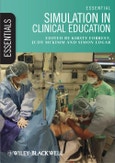This new addition to the popular Essentials series provides a broad, general introduction to the topic of simulation within clinical education. An ideal tool for both teaching and learning, Essential Simulation in Clinical Education provides a theoretical and practical introduction to the subject of simulation, whilst also offering strategies for successful use of simulators within general clinical education and demonstrating best practice throughout.
This timely new title provides:
The latest information on developments in the field, all supported by an evidence-base
Content written by a global team of experts
Discussion of policy and strategy initiatives to ground simulation within the healthcare context
Practical examples of cases, including inter-professional learning.
A superb companion for those involved in multi-disciplinary healthcare teaching, or interested in health care education practices, Essential Simulation in Clinical Education is the most comprehensive guide to the field currently available.
Table of Contents
Contributors vii
Foreword x
Glossary and abbreviations xii
Features contained within your textbook xvi
1 Essential simulation in clinical education 1
Judy McKimm and Kirsty Forrest
2 Medical simulation: The journey so far 11
Aidan Byrne
3 The evidence: What works, why and how? 26
Doris Østergaard and Jacob Rosenberg
4 Pedagogy in simulation-based training in healthcare 43
Peter Dieckmann and Charlotte Ringsted
5 Assessment 59
Thomas Gale and Martin Roberts
6 The roles of faculty and simulated patients in simulation 87
Bryn Baxendale, Frank Coffey and Andrew Buttery
7 Surgical technical skills 111
Rajesh Aggarwal and Amit Mishra
8 The non-technical skills 131
Nikki Maran, Simon Edgar and Alistair May
9 Teamwork 146
Jennifer M. Weller
10 Designing effective simulation activities 168
Joanne Barrott, Ann B. Sunderland, Jane P. Nicklin and Michelle McKenzie Smith
11 Distributed simulation 196
Jessica Janice Tang, Jimmy Kyaw Tun, Roger L Kneebone and Fernando Bello
12 Providing effective simulation activities 213
Walter J. Eppich, Lanty O’Connor and Mark Adler
13 Simulation in practice 235
Jean Ker
Simulation for learning cardiology 236
Ross J. Scalese
Assessing leadership skills in medical undergraduates 238
Helen O’Sullivan, Arpan Guha and Michael Moneypenny
Simulation for interprofessional learning 240
Stuart Marshall
Use of in situ simulations to identify barriers to patient care for multidisciplinary teams in developing countries 242
Nicole Shilkofski
Clinical skills assessment for paediatric postgraduate physicians 244
Joseph O. Lopreiato
The challenge of doctors in difficulty: using simulated healthcare contexts to develop a national assessment programme 246
Kevin Stirling, Jean Ker and Fiona Anderson
Simulation for remote and rural practice 250
Jerry Morse, Jean Ker and Sarah Race
The use of incognito standardized patients in general practice 252
Jan-Joost Rethans
Integration of simulation-based training for the trauma team in a university hospital 253
Anne-Mette Helsø and Doris Østergaard
Conclusion 254
14 The future for simulation 258
Horizon scanning: the impact of technological change 259
Iliana Harrysson, Rajesh Aggarwal and Ara Darzi
Guiding the role of simulation through paradigm shifts in medical education 267
Viren N. Naik and Stanley J. Hamstra
The future of training in simulation 273
Ronnie Glavin
Index 283








